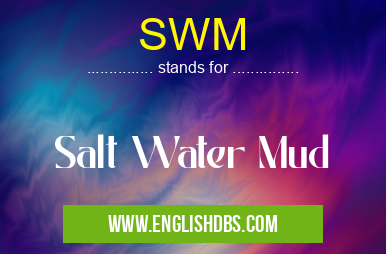What does SWM mean in UNCLASSIFIED
SWM is an acronym that stands for Salt Water Mud. In the context of drilling operations, SWM refers to a specific type of drilling fluid that is used in certain geological formations. Drilling fluids are essential for lubricating and cooling the drill bit, removing cuttings, and maintaining wellbore stability.

SWM meaning in Unclassified in Miscellaneous
SWM mostly used in an acronym Unclassified in Category Miscellaneous that means Salt Water Mud
Shorthand: SWM,
Full Form: Salt Water Mud
For more information of "Salt Water Mud", see the section below.
SWM: An Overview
Composition and Properties of SWM
SWM is a water-based drilling fluid that contains a high concentration of salt, typically sodium chloride (NaCl). The salt content in SWM can range from 10% to 25% by weight. In addition to salt, SWM may also contain other additives, such as polymers, surfactants, and weighting agents.
The high salt content in SWM gives it several desirable properties, including:
- High density: The salt content increases the density of SWM, making it suitable for drilling in formations with high pore pressures.
- Inhibition of clays: Salt ions interact with clay particles in the formation, reducing their swelling and improving borehole stability.
- Compatibility with salt water: SWM is compatible with salt water formations, as it does not react with the formation fluids.
Applications of SWM
SWM is commonly used in drilling operations in the following scenarios:
- Drilling through salt formations
- Drilling in areas with high pore pressures
- Drilling in formations prone to clay swelling
- Drilling in offshore environments, where salt water is readily available
Advantages and Disadvantages of SWM
Advantages:
- High density
- Inhibition of clays
- Compatibility with salt water
- Readily available
Disadvantages:
- Can be corrosive to drilling equipment
- May require special disposal methods
- Not suitable for drilling in fresh water formations
Conclusion
SWM is a specialized drilling fluid that is used in specific geological formations. Its high salt content provides desirable properties such as high density and clay inhibition. SWM is commonly used in drilling operations offshore and in areas with high pore pressures. However, it is important to consider the potential corrosive effects and disposal requirements when using SWM.
Essential Questions and Answers on Salt Water Mud in "MISCELLANEOUS»UNFILED"
What is Salt Water Mud (SWM)?
SWM, short for Salt Water Mud, is a type of drilling fluid used in the drilling process of oil and gas wells. It is primarily composed of saltwater, typically derived from the sea, and a blend of chemicals and additives to enhance its properties. SWM is commonly employed in offshore drilling operations where salt water is readily available.
What are the advantages of using Salt Water Mud?
SWM offers several advantages in drilling operations:
- Availability: Salt water is abundant offshore, making it a convenient and cost-effective option.
- Shale Inhibition: SWM contains certain additives that help inhibit the swelling of shale formations, reducing drilling problems.
- Lubricity: SWM provides lubrication to the drill string, reducing friction and minimizing wear.
- Corrosion Inhibition: Additives in SWM help protect the drill string and equipment from corrosion caused by salt water.
What are the disadvantages of using Salt Water Mud?
SWM has a few disadvantages to consider:
- Environmental Impact: Disposing of SWM can be challenging due to its high salt content. Environmental regulations must be carefully followed to mitigate potential ecological impacts.
- Formation Damage: SWM can cause damage to certain types of formations, especially those sensitive to salt or sodium ions.
- High Density: SWM naturally has a higher density than freshwater-based muds, which can limit its usage in deep wells where hydrostatic pressure is a concern.
What are the key components of Salt Water Mud?
The core components of SWM include:
- Salt Water: Typically sourced from the sea, it forms the base fluid.
- Barite: A mineral used to increase the density of the mud.
- Bentonite: A clay mineral that provides viscosity and sealing properties.
- Polymers: Additives that enhance mud properties such as shale inhibition and fluid loss control.
- Chemicals: Various chemicals are added to control pH, prevent corrosion, and inhibit bacterial growth.
How is Salt Water Mud managed and maintained during drilling operations?
SWM is managed and maintained throughout the drilling process to ensure optimal performance:
- Monitoring: Engineers monitor the mud's properties, including density, viscosity, and pH, to adjust as needed.
- Treatment: Additives are added to address specific drilling conditions, such as shale inhibition or lost circulation.
- Disposal: SWM is disposed of responsibly according to environmental regulations. In offshore operations, it may be reinjected into designated formations or discharged after treatment.
SWM also stands for: |
|
| All stands for SWM |
